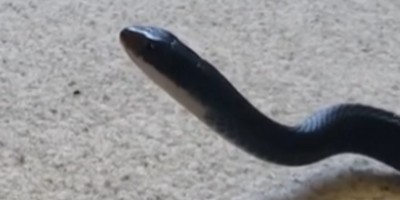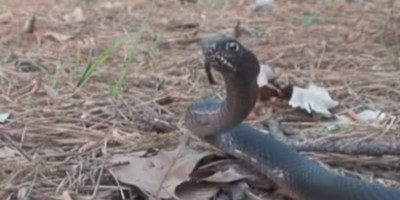
Welcome to columbiasnakes.com! I am David, a snake enthusiast living in Columbia, SC. Many people don't know that Columbia is in fact full of snakes! You just need to know where to find them - they can often be shy and elusive. Some South Carolina snake species are more common outside of the city limits, in different parts of Richland County SC, but many types of snakes are indeed common in the more urban parts of Columbia. This guide is meant to help educate you about the beautiful snakes of Columbia, and to help you identify the most common snakes of Columbia, as well as the venomous snakes of Columbia that you should learn to recognize and avoid. If you want more detail, click here for my complete list of ALL snake species in Columbia. Remember the following:
- Most snakes of Columbia are harmless and don't want to encounter you
- Venomous snakes exist but are uncommon in Columbia, South Carolina
- Snakes eat rats and mice and are a valuable part of the South Carolina ecosystem
- Never kill a snake - if you leave a snake alone, it will leave you alone.
Common Snake Species in Columbia
 Black Racer:
The southern black racer (Coluber constrictor priapus) is commonly confused with the indigo snake. Both have slender black bodies. However, the black racer can be distinguished by its white chin. They pose little threat to humans, preferring smaller prey. At their longest, they reach around 20 to 56 inches. However, the record is an impressive 72-inch monster. Despite being non-venomous, black racers detest being handled. Doing so will lead them to thrash about, releasing a foul-smelling musk typically used to deter predators. Black racers hunt for small mammals like moles and rodents, as well as lizards, insects, frogs, and other small snakes. As their Latin name suggests, they kill by constriction, coiling around their prey. In short, if they can overpower their prey, they will eat it.
Black Racer:
The southern black racer (Coluber constrictor priapus) is commonly confused with the indigo snake. Both have slender black bodies. However, the black racer can be distinguished by its white chin. They pose little threat to humans, preferring smaller prey. At their longest, they reach around 20 to 56 inches. However, the record is an impressive 72-inch monster. Despite being non-venomous, black racers detest being handled. Doing so will lead them to thrash about, releasing a foul-smelling musk typically used to deter predators. Black racers hunt for small mammals like moles and rodents, as well as lizards, insects, frogs, and other small snakes. As their Latin name suggests, they kill by constriction, coiling around their prey. In short, if they can overpower their prey, they will eat it.
 Eastern Coachwhip:
These snakes are known for their long and slender bodies, from which they earned their names. The eastern coachwhip (Masticophis flagellum) is found throughout the deep south, from Virginia to Florida and across to Louisiana. Their coloring varies greatly, from flecked dark brown to pale tan. On average, they reach 50 to 70 inches in length. Coachwhips favor sandy soil and thrive in old fields and prairies. They are non-venomous and pose little threat to humans unless cornered. They primarily hunt for mice, insects, lizards, and other small mammals. Nor do they constrict their prey, instead preferring to clamp down upon it until death.
Eastern Coachwhip:
These snakes are known for their long and slender bodies, from which they earned their names. The eastern coachwhip (Masticophis flagellum) is found throughout the deep south, from Virginia to Florida and across to Louisiana. Their coloring varies greatly, from flecked dark brown to pale tan. On average, they reach 50 to 70 inches in length. Coachwhips favor sandy soil and thrive in old fields and prairies. They are non-venomous and pose little threat to humans unless cornered. They primarily hunt for mice, insects, lizards, and other small mammals. Nor do they constrict their prey, instead preferring to clamp down upon it until death.
 Rough Earth Snake:
These non-venomous snakes are hard to spot, being both secretive and camouflaged in dark brown scales. They are fossorial, meaning they hide beneath logs, rocks, or leaf litter. Commonly found in gardens, they will not harm humans unless handled or provoked. It generally does not bite. In urban parks and gardens, they can be extremely abundant. The rough earth snake (Haldea striatula) hunts almost exclusively for earthworms. But will also eat slugs, snails, and insect larvae. Prey is swallowed whole after it is located. These snakes will burrow to catch their prey. Being only 7 to 10 inches long, they are a perfectly safe and common snake in South Carolina.
Rough Earth Snake:
These non-venomous snakes are hard to spot, being both secretive and camouflaged in dark brown scales. They are fossorial, meaning they hide beneath logs, rocks, or leaf litter. Commonly found in gardens, they will not harm humans unless handled or provoked. It generally does not bite. In urban parks and gardens, they can be extremely abundant. The rough earth snake (Haldea striatula) hunts almost exclusively for earthworms. But will also eat slugs, snails, and insect larvae. Prey is swallowed whole after it is located. These snakes will burrow to catch their prey. Being only 7 to 10 inches long, they are a perfectly safe and common snake in South Carolina.
Venomous Snake Species in Columbia
 Copperhead:
The Eastern Copperhead (Agkistrodon contortrix) is a venomous pit viper endemic to South Carolina and the eastern United States. It is responsible for the most bites, and its venom is known for being extremely painful. However, copperheads often give an initial warning bite, using very little venom. Look for a patchwork of browns, typically in a band format. The shades range from lustrous coppers to dusty browns. In length, copperheads reach between 2 to 3 ft. They have muscular bodies and noticeably triangular heads. They are found in a wide range of habitats: from woodland to craggy mountains, copperheads can thrive. This is part of the reason they do well in suburbia.
Copperhead:
The Eastern Copperhead (Agkistrodon contortrix) is a venomous pit viper endemic to South Carolina and the eastern United States. It is responsible for the most bites, and its venom is known for being extremely painful. However, copperheads often give an initial warning bite, using very little venom. Look for a patchwork of browns, typically in a band format. The shades range from lustrous coppers to dusty browns. In length, copperheads reach between 2 to 3 ft. They have muscular bodies and noticeably triangular heads. They are found in a wide range of habitats: from woodland to craggy mountains, copperheads can thrive. This is part of the reason they do well in suburbia.  Eastern Diamondback Rattlesnake:
The eastern diamondback rattlesnake (Crotalus adamanteus) is another pit viper endemic to the south-eastern United States. They are the largest venomous snake in North America, reaching up to 8 ft. in length. Like all rattlesnakes, they will shake their tails to give off the terrifying sound: if you hear it, back away. Diamondback venom is highly potent. It works by attacking blood cells and causing tissue damage, making it a hemotoxin. At worst, it can be fatal to humans.Diamondbacks are remarkable swimmers and will on occasion even climb. This versatility makes them adept predators, hunting for small mammals such as rabbits. There have even been reports of diamondbacks eating wild turkeys – albeit when young.
Eastern Diamondback Rattlesnake:
The eastern diamondback rattlesnake (Crotalus adamanteus) is another pit viper endemic to the south-eastern United States. They are the largest venomous snake in North America, reaching up to 8 ft. in length. Like all rattlesnakes, they will shake their tails to give off the terrifying sound: if you hear it, back away. Diamondback venom is highly potent. It works by attacking blood cells and causing tissue damage, making it a hemotoxin. At worst, it can be fatal to humans.Diamondbacks are remarkable swimmers and will on occasion even climb. This versatility makes them adept predators, hunting for small mammals such as rabbits. There have even been reports of diamondbacks eating wild turkeys – albeit when young.
If you're unsure, you can email me a photo of the snake at info@columbiasnakes.com and I will email you back with the snake's species. If you found a snake skin, read my Found a Skin? page, and you can email me a photo of the skin, and I'll identify the snake for you. If you need professional Columbia snake removal help, click my Get Help page, or see the below website sponsor I found, who provides that service.
Remember, the term is not poisonous snakes of Columbia, it's venomous snakes of Columbia. Poison is generally something you eat, and venom is injected into you. That said, dangerous snakes are very rare in Columbia. The few venomous snakes of Richland County are rarely seen. But they are commonly misidentified, so learn about all the snake species of Columbia in order to correctly identify them. These snakes are usually also found in the surrounding towns of Forest Acres, Hopkins, Eastover, Arcadia Lakes, Saint Andrews, Dentsville, Gadsden, Horrel Hill, Lake Murray of Richland, Woodfieldand the surrounding areas.
Read our article about:
4 Amazing Ways to Keep the Snakes Out of the Garden
columbiasnakes.com domain and hosting costs made possible by the generous support of this sponsor:
